
Photo from wikipedia
BACKGROUND The association of population mixing (PM1) with childhood acute lymphocytic leukemia (ALL2) has been reproduced in multiple studies. However, the mechanism underlying this association is unknown. METHODS Ecological study… Click to show full abstract
BACKGROUND The association of population mixing (PM1) with childhood acute lymphocytic leukemia (ALL2) has been reproduced in multiple studies. However, the mechanism underlying this association is unknown. METHODS Ecological study of incidence of pediatric ALL among 253 counties in the State of Texas (USA) using surrogates of genetic and environmental PM. ALL incidence data were obtained from Texas Cancer Registry and county population statistics from the US Census Bureau. Poisson regression was used to compare ALL incidence and PM. RESULTS There is substantial and variable genetic and environmental PM among counties in Texas. Indicators of genetic PM including proportion of multiracial households, ratio of Hispanics to non-Hispanics, and ratio of foreign to native-born residents were all significantly associated with a higher incidence of ALL (IRR3 1.81 (95CI 1.05-3.13), 1.67 (95CI 1.16-2.37), and 1.59 (95CI 1.03-2.48), respectively). Surrogates of environmental PM namely population density and persons per household were not associated with incidence of ALL; IRRs 1.29 (95CI 0.4-4.15) and 1.47 (95CI 0.89-2.43). CONCLUSIONS These findings are consistent with prior patterns and magnitudes of PM association with ALL. Our findings suggest that the implicated mechanism of leukemogenesis in PM may be genetically transmitted rather than environmental.
Journal Title: Cancer epidemiology
Year Published: 2020
Link to full text (if available)
Share on Social Media: Sign Up to like & get
recommendations!